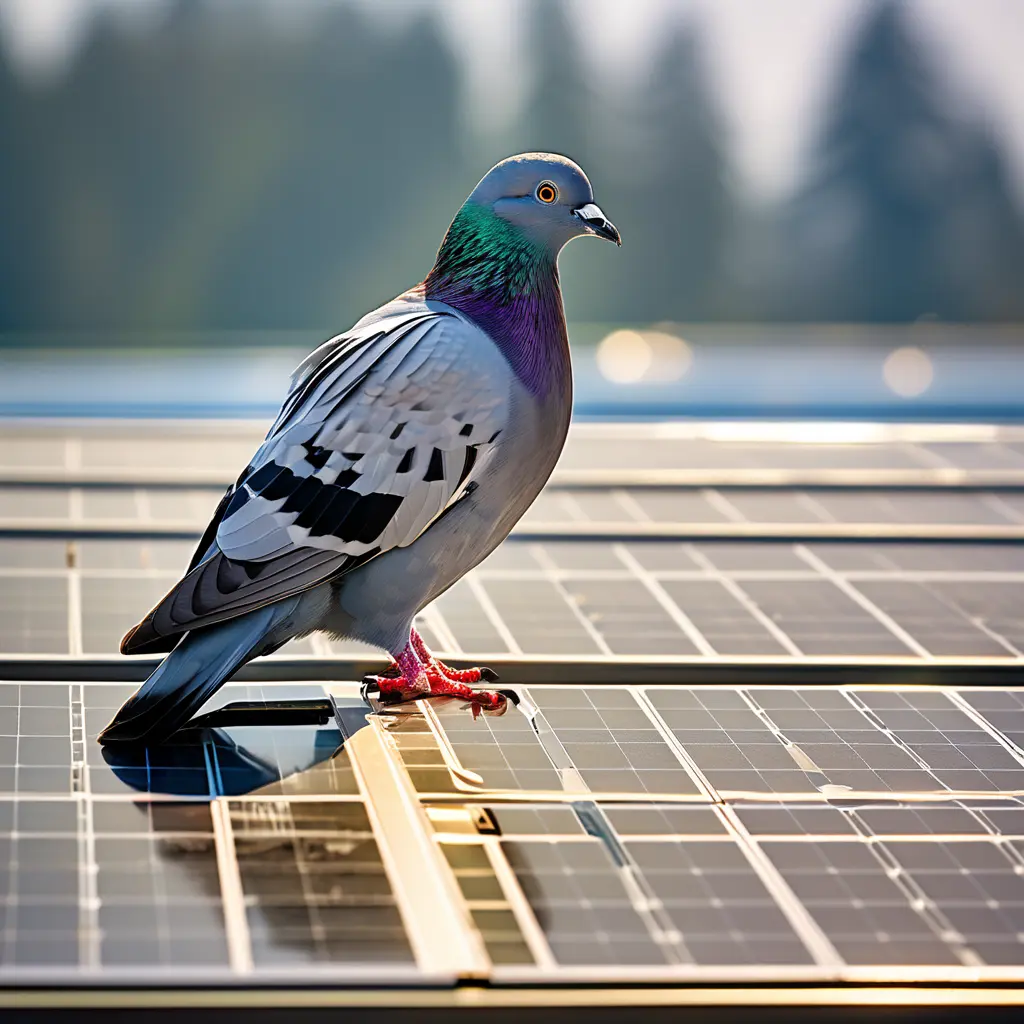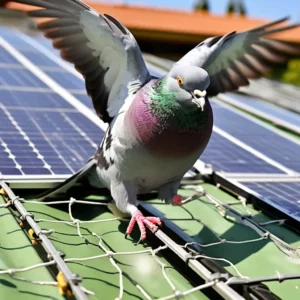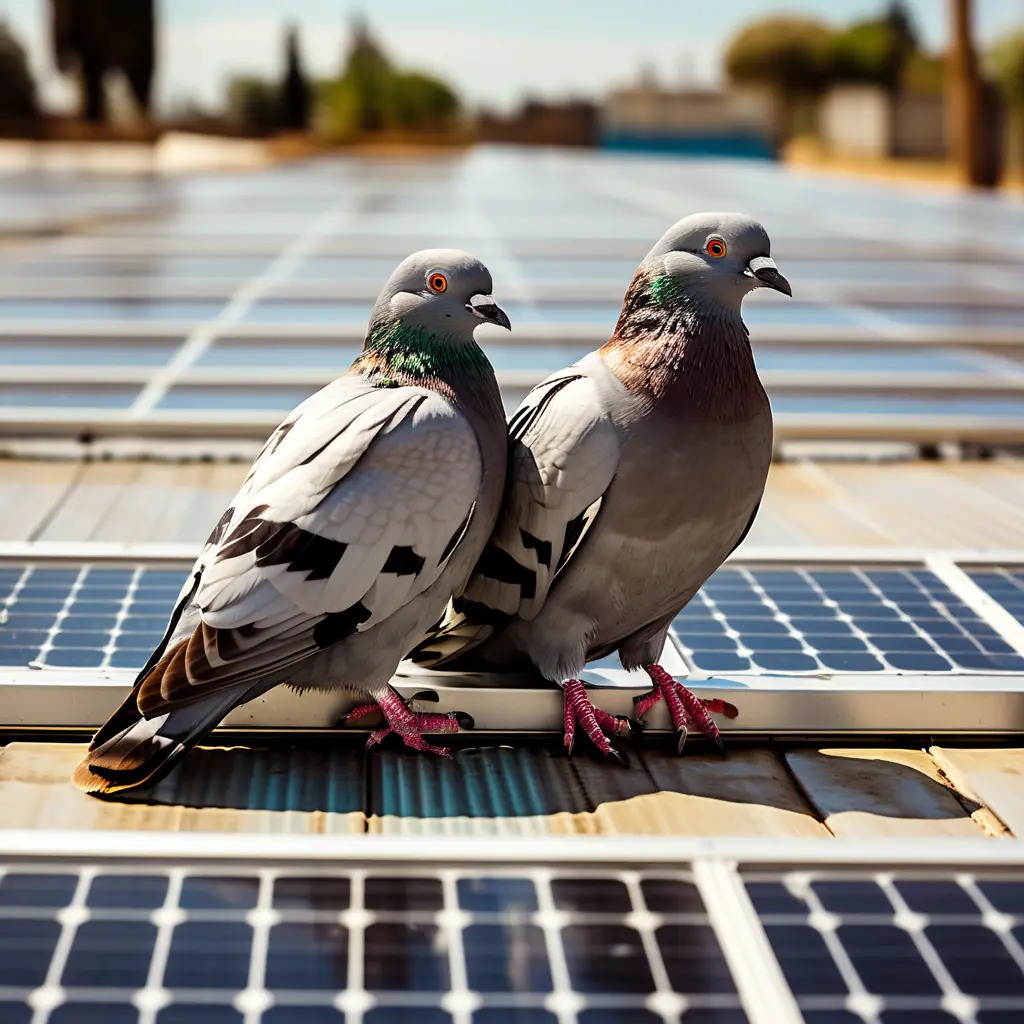How Much Does It Cost To Pigeon Proofing Solar Panels ?
Investing in solar panels is a significant financial commitment, and ensuring their long-term benefits requires ongoing maintenance. The impact of bird droppings on a solar panels performance surpasses dust buildup. Over time, bird droppings and debris build up, creating a messy cleanup job and potential hazards. Consequently, regular gutter cleaning and implementing bird-proofing measures become essential.
Pigeon proof solar panels typically costs between $200 and $1500. However, this price can vary based on factors such as the number of solar panels in your system, the slope of your roof, the height of your roof, and whether the removal of nests or birds is necessary before installation. Read on to learn more about.
Why Do Birds Like Solar Panels So Much?

Without proper precautions, birds pose a significant challenge for solar panel owners, creating frustration and complications. Bird-B-Gone scientists discovered three main reasons why birds are attracted to solar panels after years of research.
1. Warm Habitat for Birds:
The primary and most apparent advantage of solar panels for birds lies in the cozy, warm habitat they provide. Solar panels, designed to enhance photovoltaic energy absorption, have a dark tint that efficiently heats up and retains warmth. These features make solar panels ideal bird nesting sites, as they constantly seek warm and tranquil locations to rest and build nests.
2. Safety:
Second reason is safety.. Like any other creature, birds need a secure space to raise their young, rest, and evade predators. The gaps in solar panels offer a protected area where birds can safely nest, with openings large enough to fit through.
Solar panels offer shade for birds during the hot summer months. This helps them cool down and regulate their body temperature. It also provides a place for them to escape the heat.
3. Easy Movement:
Birds are attracted to solar panels because they provide ease of movement. Solar panels on roofs provide birds with a clear view and the ability to move freely in all directions. This can be helpful if they need to escape from a predator that is near their nests.
The panels offer birds a safe space to seek refuge and protect themselves. The elevated position of the panels allows birds to survey their surroundings and detect potential threats. Accessibility and ease of access to a nest are crucial factors for birds, alongside safety and security.
Lets find ways to protect them from birds and see how much it will cost. Taking steps to mitigate these attractions can help maintain the efficiency of your solar panels and prevent potential complications.
How Can Protecting Solar Panels From Pigeons Help?

Protecting solar panels from pigeons is important. This keeps solar safe and maintains the propertys well-being. Here are some key benefits of pigeon-proofing solar panels:
1. Prevention of Damage:
Pigeons nesting beneath solar panels can cause significant damage. They may scratch the surface of the panels with their claws, leading to scratches and reduced efficiency over time. Additionally, pigeons can dislodge or damage wiring, posing a risk of electrical malfunctions.
2. Mitigation of Health Risks:
Pigeons carry various parasites, including mites, lice, and fleas, which can infest the area around the solar panels. Pigeon droppings, in particular, can harbor harmful pathogens such as E. coli, salmonella, cryptococcosis, histoplasmosis, and toxoplasmosis. By preventing pigeons from nesting, we minimize the risk of exposure to these health hazards.
3. Fire Prevention:
Pigeons often use materials like sticks and debris to build their nests. If these materials come into contact with the live wiring of solar panels, there is a potential fire risk. Pigeon-proofing helps eliminate the possibility of nests causing a fire and protects the property from this hazard.
4. Avoidance of Flooding:
Pigeon nests beneath solar panels can accumulate debris, causing drainage issues. If rainwater cannot flow freely, it may lead to flooding, putting the solar panels and their wiring at risk. Pigeon-proofing ensures proper drainage and helps prevent water-related damage.
5. Preservation of Aesthetics:
Pigeon droppings pose health risks and mar the visual appeal of solar panels and the surrounding area. Pigeon-proofing measures, such as netting or spikes, maintain the cleanliness and aesthetics of the solar panel installation.
6. Long-Term Cost Savings:
While there is an initial investment in pigeon-proofing, the long-term cost savings outweigh this expense. Keeping solar panels clean and well-maintained can save money in the long run. This is because it reduces damage, health risks, and cleanup needs.
Keeping pigeons away from solar panels helps them work better, last longer, and stay safe. Property owners should address pigeon problems early to save money and prevent issues when installing solar panels.
Bird Proofing Material Cost
Bird spikes cost less than $15 for 3-foot lengths, with around $200 to bird-proof a typical roof. Metal or net mesh covers range from $300 to $500, offering comprehensive protection. Predator replicas, like owl statues, are budget-friendly at $20 to $30, but may benefit from combining with other deterrents for effectiveness.
Several options exist for safeguarding solar panels from bird interference, each with its associated costs. Here are three commonly used methods, along with their respective price considerations:
1. Bird Spikes:
People use bird spikes to deter birds from landing on or near solar panels. They place them on roof sections to make it uncomfortable for birds. This helps to protect the solar panels from damage caused by bird droppings and nesting.
Cost: Bird spikes offer a cost-effective solution, with 3-foot lengths for less than $15. The overall expense for bird-proofing a typical spiked roof is approximately $200. However, some may find them less visually appealing.
2. Metal or Net Mesh:
People use metal or net mesh to cover solar panels, preventing birds from landing or nesting on them. This method provides comprehensive coverage but may require more frequent maintenance.
Cost: The metal or net mesh cost varies, generally ranging from $300 to $500. The cost varies based on the size of the solar panel system and how complicated the installation is. Although it is somewhat pricier, people consider it a more durable and visually pleasing solution than bird spikes.
3. Predator Replica:
This approach entails placing replicas of predators, such as owls, on the roof. The presence of these statues acts as a scarecrow, deterring birds from approaching the solar panels.
Cost: Predator replicas are budget-friendly, typically between $20 and $30. While they may be the least expensive option, other deterrents can enhance their effectiveness.
Selecting the Best Option:
The best way to keep birds away from solar panels depends on personal choice, panel size, and how it looks. Bird spikes are cheaper, but metal or net mesh offer better protection and look nicer. People who want long-lasting results and a better appearance prefer metal or net mesh. Predator replicas present a budget-friendly alternative, especially when used with other deterrents.
Choosing the right bird-proofing solution involves balancing cost, effectiveness, and aesthetics to meet your needs. Finding the right balance is key to ensuring that the bird-proofing solution is effective and meets your requirements.
What is the Best Way to Protect Your Solar Panel from Birds

Protecting your solar panels from bird interference is crucial for their efficiency and longevity. Using metal or net mesh is a great way to keep birds away from your solar panels.
Metal or Net Mesh:
This technique involves installing a metal or netting protective barrier over the entire solar panel array. The barrier is a deterrent, preventing birds from landing or nesting on the panels.
Benefits:
Metal or net mesh completely covers the panels, ensuring that birds cannot access them.
This method is more long-lasting than some alternatives, providing extended protection against bird interference.
Many people consider metal or net mesh visually appealing for solar panels. It helps maintain the overall aesthetic of the panels.
Metal or net mesh may be more expensive initially compared to bird spikes. However, the benefits in the long run justify the investment. The upfront cost of using metal or net mesh may be higher than bird spikes. Nevertheless, the advantages over time make it a worthwhile investment.
The best way to protect your solar panels from bird damage and improve the look of your solar setup. Using metal or net mesh can keep birds away from your solar panels. This will ensure that birds do not interpret with your solar energy investment, maximizing its potential.
Final Words
There are two main ways to keep birds away from solar panels: using bird spikes or putting up mesh or wire. While neither option is perfect, netting proves to be the superior choice. It looks better and is safer for birds because spikes can sometimes hurt a bird\’s foot. Additionally, netting is more efficient in preventing bird interference.
Considering the higher quality of netting as a product, we recommend investing additional funds in this option. You can implement both bird spikes and netting as do-it-yourself projects, which allows for cost savings. If you hire someone to help, it will cost at least $1,000 to protect your solar panels from birds.
